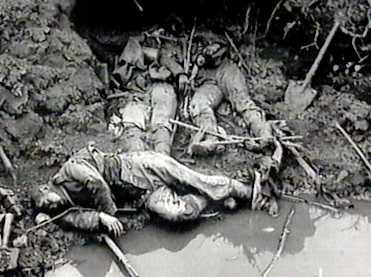|
Back to
the Homepage
Battle Verdun
The Battle of Verdun and the number of casualties
Nothing can be said of the number of dead, wounded and missing for certain. The official
French war history that was published in 1916 estimates the French losses at Verdun at
377,231. Of this number 162,308 are dead or missing. The most reliable estimates of the
German losses mention 337,000 of which 100,000 dead, wounded or missing (Reichsarchiv,
Potsdam, 1918). The total amount of casualties would then be: 714,231 of which 262,308
dead, wounded or missing. (Note: this number does not yet include the number of prisoners
of war that returned after the war.)
| French losses: |
337,231 |
of which 162,308 dead or missing |
| German losses: |
337,000 |
of which 100,000 dead or missing |
| Total: |
714,231 |
of which 262,308 dead or missing |
In his book Death of a Generation Alistair Horne has included a
monthly statement of
the French and German victims for the period: February - August 1916 (without
acknowledgement).
| Month: |
French losses: |
German losses: |
February |
24,000 |
25,363 |
March |
65,000 |
56,244 |
April |
42,000 |
38,299 |
May |
59,000 |
54,309 |
June |
67,000 |
51,567 |
July |
31,000 |
25,969 |
August |
27,000 |
30,572 |
Total |
315,000 |
282,323 |
(Note: the numbers
of September - December are lacking!) |
In his book The World Crisis Churchill mentions much bigger
numbers, but these are numbers from the entire Western front. The victims fallen outside
the Verdun area should not be included.
Over the years al lot of numbers have been
mentioned. 362,000 French and 336,831 Germans (so nearly 700,000 men) are believed to be
killed in the mincer of Verdun (no source). Ernst Glaeser speaks of 300,000 unidentified
casualties. Kurt Tucholsky even claims 400,000 French casualties. In his book Le Drame
de Douaumont general J. Rouquerol mentions 2,000,000 (sic!) men (French and German)
who fell "on the fields that are today lit by the lighthouse of Ossuaire". The
Dutch author H. Jonkers takes his data from Rouquerol: 700,000 wounded and 1,000,000
fatalities.
The concept "losses" is not very clear. The word applies to every single person
who is (temporarily) not available for active duty any more. At the front this would
indeed be the dead and wounded, but in the number of losses are included also: missing
persons, men with the flu, a pneumonia, an inflammation of the jaw, etc. Even the
prisoners of war, who escaped the battlefield in this special way, are included in the
number of victims.
The accuracy of the numbers is often questioned, therefore estimates are used. The
statistics use a general ratio of 1 : 3 for the ratio dead : wounded. This would mean
that the total number of "dead and missing" could be around 180,000, based on a
total number of victims of 714,231.
German Werth based his numbers on the Sanitätsbericht über das Deutsche Heer of
21 February to 10 September (further data is not available). The total number of
troop-fall out was 708,524 based on an average of 572,855 men (number of men in the Vth
army corps). Of this total fall out 275,770 recovered and 75,000 returned from the
military hospital. The total number of losses then adds up to: 708,524 - (275,770 +
75,000) = 357,745 men. (Note: this is still 62.5% of the average number of men in an army
corps.) In the end Werth settles for 81,668 German dead and missing. This is 22.8% of the
total number of German victims.
The French numbers probably have to be adjusted as well. Perhaps they are similar to the
German numbers percentage wise. It seems probable that the total amount of victims
(rounded off) can be estimated at 358,000 Germans (according to Werth) and 400,000 French.
(The French number, as can be found in the first paragraph, is over 10% higher than the
German number.) Total amount: 758,000.
The number of dead men would then fluctuate between the 22.8% of Werth and the 25% that
stems from the normal rate of 1:3. The average is then nearly 24%.
The total number of fatalities would then be: 24% of 758,000 = 182,000!
(Note: this number does not include the returned prisoners of war. On this there are no
accurate numbers available.) However, in reality the losses are even larger than appears
from these numbers. You see, included in this number should be as well: the mutilated, the
psychiatric patients, the blinded, the crippled, the victims of gas, and all the others
who in fact did survive the war, but were not able to function in society ever again.
Back to the Homepage Battle
Verdun
|
